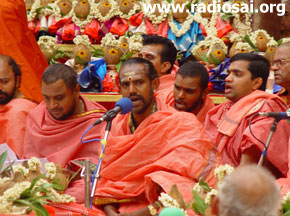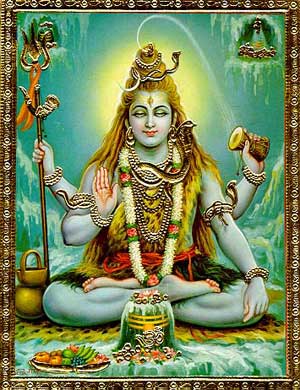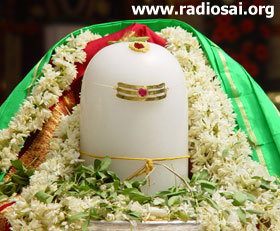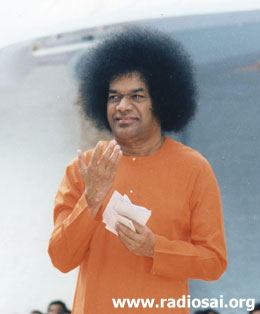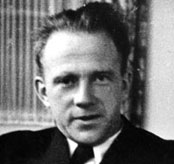| |
The Athi Rudra Maha Yagnam
THE PROFOUND SIGNIFICANCE BEHIND THE POWERFUL SACRIFICE
We reproduce below, the text of a special Musings talk by Prof G. Venkataraman on the subject of Ati Rudra Maha Yajna, broadcast earlier over Radio Sai.
Loving Sai Ram, and greetings from Prashanti Nilayam. The Ati Rudra Maha Yajna is now in full swing here, and it is only appropriate that I devote this special talk to that subject. Before I say anything on the Yajna proper, I must first offer the disclaimer that I am no Vedic scholar. Whatever I say on the technical aspects is based on material I have gathered from various sources, including scholars behind the event here. It is likely that there could be errors due to the incompleteness of my understanding, for which I make my apologies in advance.
The Ati Rudra Maha Yajna is addressed specifically to Lord Siva; as such, my remarks would be structured as follows:
I shall begin by saying something about this particular Yajna, the chanting aspects that is.
- Next, considering that this Yajna is addressed to Lord Siva, I shall say something about Siva, how He is represented, and what that representation means.
- This would then lead me on to some more comments about the chants that characterise this particular Yajna.
- After this, I shall say something about what really lies behind ritualistic worship, etc.
- I shall then wind up with a few general remarks on the broader significance of this Yajna and why it is important.
The Chants of the Rudram
With this preamble, let me get down to business and start with Rudram. The word Rudram usually refers to a special chant, a celebrated one actually, that occurs in the Yajur Veda. The Rudram is heard almost everyday here in Prashanti. I should point out that what is commonly referred to as the Rudram, has two parts; the first of these is called Namakam while the second one is called Chamakam. Most of the hymns of Namakam end with the words namo or namaha. Similarly, the ending of many of the hymns of Chamakam is cha me. The hymns are organised into portions called Anuvakams.
Normally, one chant of the Namakam followed by one chant of the Chamakam constitutes one Rudram. There is a long-standing traditional belief that chanting the Rudram confers benefits of various kinds. For example, chanting it a few times grants freedom from disease, worldly difficulties, etc. As the number of the repetition increases, one is supposed to get progressively more and more benefits but at some stage, the benefits switch from being worldly to spiritual, the culmination being becoming one with God.
In functions like the one going on here, the word Rudram representing the basic unit of chant is defined slightly differently. Glossing slightly over the details, the basic unit consists of the chanting of the Namakam 11 times followed by one chant of the Chamakam. If eleven persons do this simultaneously, we have essentially 11x11 or 121 collective chants, which is called Ekadasa Rudram.
|
|
|
| |
|
Mellifluous mantras |
When the basic module is chanted 11x11x11 or 1,331 times, we have a Maha Rudram, and when it is chanted 11x11x11x11 or 14,641 times, we have an Ati Rudram. In the present Yajna, this total score of 14,641 repetitive chants of the Rudram would be achieved by 121 priests doing the chants over 11 days. That roughly is the bookkeeping as far as the chants are concerned. For the record I should mention that this total score of 14,641 could be achieved by one individual, of course, spreading the chant over many, many days; on the other hand, with a large enough team, it could all be done in one day itself. I should also mention that while this is the first time the Ati Rudra Maha Yajna is being performed in Prashanti Nilayam, the Maha Rudram version has been performed once, way back in 1955.
Ritualistic worship does not consist merely of Vedic chants, though chants form the backbone. Often they are accompanied by procedures of various kinds, the most important of which in this case are 1) Abhishekam and 2) offerings made to the sacred fire, or Homam as it is called. In the current Yajna, the Abhishekam would be offered to a special Lingam, everyday. The Yajna also features eleven sacred fires, to which offerings are made, once again to the accompaniment of chants based on the Rudram. Maybe you have not understood all that I have said but let that not bother you. Soon we shall be bringing out a video documentary that would enable you to actually see all that I am now describing with words.
Worshipping The Form of God
Let me now turn to Lord Siva, to whom this Yajna is specifically addressed. Who exactly is this Siva? Folklore is of course full of details about who Siva is, but I would like to view the matter in a slightly larger perspective than usual.
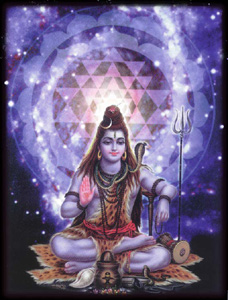 |
|
In the ultimate analysis, Siva is one of the many names by which the Supreme Creator is known. Now all who believe in God agree without exception that the Universe exists because a Creator willed it into existence. Whether this Universe came into existence via the Big Bang, as scientists including myself believe or as described in various theologies, is a different matter; despite these differences, all theists believe that God created the Universe of which we are a part.
Most religions not only agree about the existence of a Supreme Creator but also declare that God is abstract, formless, eternal, omnipresent, omnipotent and omniscient. However, different religions choose to call this God by different names but that detail need not bother us. Now the human Mind, as Krishna declares in the Gita, is infinitely capable; yet, ordinary people do not experience the infinity that the Mind represents. Thus, for ordinary people, the concept of an abstract, formless and infinite God is not easy to grasp. Different religions try to deal with this problem in other own different ways, via the intermediary of convenient symbolism. In this respect, Hinduism is perhaps the most liberal, leaving it entirely to the individual to adopt whatever form the individual wants, and thus conceptualise God with Form in many different ways. At the same time, while encouraging the worship of God with Form in order to develop Love for God, ancient Indian scriptures always viewed rituals etc., as a stepping stone to the ultimate realisation that individual is not the body but the Real Self or God. |
One depiction of the Cosmic Shiva |
|
|
In other words, worship of God was a graded process, which took one from regarding God as a great provider to something indescribable, beyond attributes, eternal, and beyond Space and Time itself, and who was the Self within.
As Swami has pointed out, Bhakti is first developed via rituals because they help one to relate personally to God. However, rituals are like floatation aids that people learning to swim first use; once they know how to swim, they throw away the aids. In the same way once the spirit of devotion is established firmly in the heart of the devotee, he or she should move to the higher realm of relating to God directly on a Heart to Heart basis.
Understanding The Significance of the Form
Let us now look at all this in some detail, with specific reference to Lord Siva and the procedures that are being followed in the Ati Rudra Maha Yajna now in progress here. As I mentioned earlier, the human Mind ascribes to the Formless God a specific Form so as to be able to easily relate to the Almighty.
Where Siva is concerned, the traditional description, together with the significance of the attributes is as follows:
-
Siva has three eyes. Many meanings have been given to the significance of the three eyes of which the one due to Swami is the most fitting. Bhagavan Baba says that one eye tells us that God knows the past; the second eye means that God knows the present. Humans have two eyes and therefore they too can claim they know the past and the present, though of course they cannot know the past relating to earlier births. As for the third eye, it signifies that God alone knows the future.
- Siva has matted hair, and apparently matted hair represents God as the Lord of breath, which is present in all living beings.
- A crescent moon adorns the head of Siva. This crescent moon has many interpretations, the most important of which is that the moon represents the progression of time. In that sense, the message that Siva’s moon sends to us is that God is beyond Time and the absolute master of it as well.
- The drum in the hand of Siva is a symbol of sound, the basis for language.
|
|
|
| |
|
The 'Attributes' of the Lord |
- Siva wears the skins of the tiger, the elephant and the deer. The tiger represents power that pervades the universe; thus, the tiger skin symbolises mastery over every force. The elephant represents pride and wearing the elephant skin, Siva sends the message that to become one with God, one must first conquer pride. Similarly the deer, which makes big leaps, represents a fickle Mind; and wearing the deerskin, the message sent is that Mind must first be stilled, if one wants liberation.
And so on the list goes. I am not saying that my description is the only way of understanding the symbolism. The point is somewhat different. Once one gives a Form to God, one also starts assigning attributes. However, the assignment of attributes is done in such a manner as to remind the devotee that God is beyond the attributes associated with the phenomenal world.
Getting back to the specific form of Siva in which devotees visualise Him, is this form of God unique? By no means - God has endless Forms. Then in what Form does He grant a clear vision to the devotee? The answer is that He manifests in the Form the devotee yearns for, the Form that would grant the devotee the highest satisfaction. Speaking humorously, Swami once said that if a buffalo were to become very devout, it would quite likely think of God as a Super Buffalo and when God grants it a Vision it would in fact be as a Super Buffalo.
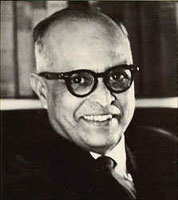 |
|
The famous Indian novelist R. K. Narayan wrote a humorous story about the efforts of a tiger to become spiritual, by seeking enlightenment from a Guru. One day, the Guru asks the tiger to describe God, and the tiger replies:
God must be an enormous tiger, spanning the earth and sky, with a tail capable of encircling the globe, claws that could hook the clouds, and teeth that could grind mountains, and possessing of course, immeasurable strength to match.
Hearing this, the Guru bursts into laughter and replies, “You may be perfectly right in thinking of your God as a super tiger. Also, it may be true. In the Bhagavad Gita, God reveals Himself in a mighty terrifying form, which pervades the whole universe in every form of life and action. Remember also that He is within every one of us and we derive strength from Him.” |
Sri R. K. Narayan |
|
|
So we arrive at the conclusion that while the name Siva and the specific form attributed to Him are useful in their own way, we must really look beyond the form to the Formless aspect of God. I shall return to that shortly. But for the moment, I would now like to turn to the rituals.
How Rituals Bind Devotee To The Lord
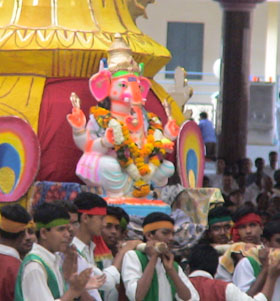 |
|
A ritual is basically a form of worship in which chants are accompanied by certain procedures. This is best illustrated by the simple worship of Lord Ganesha that precedes practically every ritual here. In this there is a small idol of Lord Ganesha, and after the preliminaries are over, the devotee first welcomes Ganesha. And how does he do it? By seating Ganesha on a plank and making the gesture of washing the feet. This symbolism has a specific meaning.
In the olden days, whenever an elder or a revered guest came to a house, the first thing that the host did was to seat the guest and wash the feet of the guest. Next, Ganesha is given a bath, after that He is given clothes, followed by the offering of the sacred thread, sandalwood paste, etc. etc. Full hospitality is extended. Ganesha is then worshipped with flowers, after which He is offered food, fruits etc., topping it all off with Aarathi, as a gesture of reverence and worship.
These days, hardly anyone goes through this routine in the spirit implied in the procedure but that does not take away the spirit. The devotee relates very intensely on a one to one basis with the Lord, even as he would with say his Guru, dropping in for a visit. There is love and respect in every word and every gesture associated with the welcome. Sometime ago, we did a feature in H2H on Saint Tyagaraja, a life-long devotee of Lord Rama. [Click here to read again]. |
Worshipping Ganesha |
|
|
Tyagaraja had a set of idols representing Rama, Lakshmana and Sita. For him, however, they were not idols but God personified. Tyagaraja related to them in an intensely personal way, and when, for example, the idols were seized by his brother in an act of jealousy and thrown into the river, Tyagaraja became extremely distraught. And when he discovered the idols, by Divine Grace of course, how happy he became and how joyously he welcomed the Lord back into his home!
Bhakti or the intense worship of the personal God, even if it were via rituals, enables the devotee to have an intense, personal and mystical relationship with God and offer Love to God easily. That is why in the Gita, Krishna recommends the worship of the personal God, that is, God with Form, as compared to the worship of the Formless God.
Let me at this stage briefly recap what I have said thus far. I started off with some bookkeeping details about how many times the Rudram is chanted during the Ati Rudram Maha Yajna. I then talked about visualising God in the form of Siva, with all the attributes that are ascribed to Him. That was followed by some remarks about how worship of God with Form is very helpful in the spiritual path, and how Krishna Himself recommends it over the worship of the Abstract, Formless God, which can easily derail the ordinary person. I also described, especially via a brief reference to the Puja done to Lord Ganesha routinely, how ritualistic worship enables one to relate in a personal way to God. This sets the stage for me to make now a few remarks about some of the procedures followed in the Ati Rudra Maha Yajna.
The Rituals of the Athi Rudra Maha Yajna
Leaving aside the many satellite rituals, the three basic rituals are 1) chants accompanied by Abhishekam done to a Lingam, 2) the stand-alone chants of the Rudram, and 3) chants accompanied by offerings to the sacred fire, that is, Homam. Let me start with the Abhishekam done to the Lingam. What really is a Lingam? As Swami has pointed out in many of His Sivarathri Discourses, Lingam is basically a representation of Creation. When the Lingam is worshipped, one is symbolically thanking God for all the bounties Creation is filled with, like air, water, land etc., the Sun that gives us energy, and so on. For example, one of the hymns in the Namakam goes in part like this:
Prostrations to the Lord of all bodies, the destroyer who protects with His stringed bow.
Prostrations to the charioteer, the indestructible one, the Lord of the Forests, Prostrations to the crimson one, the Lord of trees who, existing in all, protects.
|
|
|
| |
|
The Lingam Adorned by Bhagavan with a Red 'Eye' |
Clearly, a person immersed in the world has desires. Swami says if you have to beg, better to beg from God than humans. In that spirit, some of the hymns unabashedly seek favours like this one that I quote in part:
May I be provided material comforts in abundance in my life’s journey and the capacity to put them to the best use.
Here is another sample:
May I be granted movable and immovable property and plentiful gold and silver.
But there are also hymns that seek higher knowledge, the ability to sacrifice, the realisation of the ultimate purpose of life and so on.
If we take all this together, we see an interesting progression. First, the devotee adores the Lord as the Supreme Creator and seeks from the Lord the blessings of material prosperity etc., all of which are related to Creation. But slowly the devotee’s focus shifts to things more spiritual, that is, to things that go beyond the mere material.
Life As A Pilgrimage
Let me now try and put all this in a larger perspective. Basically, one can visualise the rituals as a symbolic representation of life as a pilgrimage. Initially, one does not understand that God is the Indweller who resides within us. Thanks to this ignorance, one seeks God outside, in manmade temples, in so-called holy places, etc. One also tries to do one’s duty but the Mind is agitated by the consequences of the past, one’s karma that is. As a result, one prays to God for protection, freedom from troubles and so on. If this part of life is handled properly, the Mind slowly develops some maturity and helps the individual to focus more on fulfilling his or her Dharma. As the focus on Dharma increases, the individual seeks to become united with God because that grants true Peace and Bliss. And this process is facilitated by the individual seeking God within rather than outside.
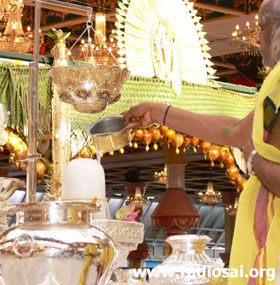 |
|
In passing, I should perhaps mention the following. These days when one has a bath, one takes a shower, at least in the advanced countries. In India in the olden days, people used to bathe in the river or when they took a bath at home, they would pour water over themselves using a metallic mug. And while bathing, many would chant the Rudram. The idea was that bathing of the physical body, was symbolic of performing Abhishekam to the Lord inside.
To put it all differently, worship symbolises a three-step process as it were. In the first step, we come to grips with our karma, that is, the consequences of our past lives, often painful. That pain compels us to seek God and pray to Him for favours. As we work out our karmas and acquire some spiritual refinement, we slowly become focussed on Dharma. This propels us forward on the spiritual path, helping us to discriminate the false from the true. In particular, we progressively move away from material objects and sensual pleasures to things more eternal and permanent, that is, values that transcend Creation. That takes us on a beautiful inward journey that culminates with coming face to face with Supreme Consciousness and finally becoming one with it. |
Performing Abhishekam to the Lingam |
|
|
Thus far, I have talked about the spiritual progress of an individual. Indeed, most Gurus have in the past, been mainly preoccupied with helping individuals to go from the finite to the Infinite, from the transient to the Eternal, from untruth to Truth etc., etc. In this sense, the spiritual journey was essentially seen as a lonely trek by an individual. In a radical departure from this traditional approach, Aurobindo in his rather difficult to read Integral Yoga, ventured to suggest that mankind has reached a stage where a whole body of people could and must collectively evolve. Even more interesting is the fact that our beloved Swami has been quietly translating Aurobindo’s rather fuzzy theoretical concepts into practical reality, with what I would call a truly revolutionary approach.
Sai’s Mission to Uplift Humanity
Take, for example, Swami’s Institute. On the face of it, it is a University that like its counterparts elsewhere, offers courses in mathematics, physics, chemistry, etc., besides other courses on Business Administration, Financial Management, Computer Science and so on. That is what one sees on the surface; but look below and you would find that Bhagavan Baba’s University is a spiritual cauldron of a unique kind that produces every year in a coherent and structured manner, hundreds and hundreds of young men and women who are ready to serve humanity and uplift it in many different ways.
Look next at the Seva Organisation founded by Swami. As Bhagavan once remarked, the basic aim of the Organisation is to spirituality elevate the individual engaged in Seva, but when thousands and thousands do selfless seva round the world throughout the year, it has its own collective impact in uplifting a large number of people.
The same is true of Swami’s Hospitals. On the face of it, the Hospitals help the poor by offering them free medical service, including at the advanced level. But look deeper and what do you find? These Hospitals provide a wonderful chance to so many doctors and nurses to do real service. Then there are the large number of Swami’s students who are serving as Technical Officers for a modest salary, even though they can command much bigger pay outside, given their highly specialised skills. And let us not forget the many others who are serving in the Hospitals in various capacities, purely on a voluntary basis. Finally, there are the huge Seva Dal brigades that come week after week, from all over the country, to engage in a variety of support services that range from security duty to laundry work, carrying food to the patients, pushing wheel chairs, and so on.
In every one of the institutions created by Swami, groups of people working coherently together and for a common noble cause, get collectively elevated, spiritually that is. And the beauty is that people involved get uplifted without being conscious of it. Superficially it seems to sort of just happen; not really, because Swami is there behind, silently orchestrating it all. That is what is unique about this Avatar; He has come not merely to give a helping hand to individuals here and there but to large sections of humanity.
|
|
|
| |
|
Working as Worship...Sevadals at the hospital |
In physics, we have a phenomenon called self-organisation where a collective system, under some special conditions, exhibits extra-ordinary properties. Superconductivity is a classic example. A wire made of lead can conduct electricity, but when the electrons flow in the wire to carry current, they normally experience resistance. If the resistance is high, the wire in fact gets hot. But take a wire made of lead and cool it to a temperature close to absolute zero; and you know what happens? Miraculously, the electrical resistance vanishes completely and the electrons can flow without facing the slightest impedance. This is an example of self-organisation; when the conditions are right, the entire system goes over to a very different state and the behaviour of the system changes dramatically.
 |
|
The laser is another great example. A laser is basically a system the atoms of which emit light. A fluorescent tube also emits light; so what is the difference between the light emitted by fluorescent tube and that emitted by a laser? The atoms in a discharge tube emit light in all directions and with a range of frequencies. The atoms in a laser behave differently. Firstly, the light emitted comes out in one direction; secondly the frequency range is very narrow and thirdly, the atoms all emit light in step as it were.
That is what makes the laser light very powerful, so powerful that in suitable cases it can even drill through thick steel plates. Here too, once the conditions are right, the system just fires and starts lasing, as scientists say; this also is a case of self-organisation.
|
Laser Light |
|
|
Swami is telling us that when individuals in Society all are in perfect step with Dharma, then automatically that Society would become self-organised and transform into Utopia. This is how the so-called Golden Age would dawn, when mankind becomes self-organised by resonating to Dharma, and not through the wave of a magic wand as many seem to imagine.
In passing, I might add that unknown to us, Swami is nudging us forward with some incredible but hardly noticed steps. I shall mention just two. I don’t know how many of you were born at the time of the famous Cuban missile crisis in the early sixties, when Kennedy was the President of America and Khrushchev was the boss of the erstwhile Soviet Union. I remember those days vividly. There was an eye-ball-to-eye-ball confrontation between the two great super powers and it seemed for a few days that the whole world might go up in a nuclear holocaust. Tough messages were being exchanged between the two world leaders, and at a crucial moment Kennedy had the option to send almost an ultimatum or to send a slightly conciliatory message that would enable Khrushchev to back off without losing face. Kennedy chose the latter option and dramatically the crisis eased off.
Historians might praise the statesman-like approach taken by Kennedy but we must realise that ultimately our actions are determined by inner promptings. If the promptings are good then so are the resulting actions. Narrating the story of Dhruva, Swami once said that when young Dhruva, a mere five-year old, was on his way to the forest to do tapas, Sage Narada asked the young lad where he was headed. Dhruva replied that he was going to the forest to do tapas. Narada then asked, “And how exactly do you plan to do the tapas?”
Dhruva calmly replied, “He who put the idea in my head about going to the forest would also guide me how to perform the tapas!”
Yes, God often works that way, without making Himself very evident. As Swami once declared, “Coincidence is a miracle where I hide Myself!” This reminds me of another great historical event, the meeting between Ronald Regan and Gorbachev that resulted in a remarkable détente and led to the drastic reduction of the nuclear arsenals held by America and Russia. Subsequently there was a dramatic change in Russia to the point where we now actually have so many Russians coming to Prashanti Nilayam, something we simply could not have dreamt of, say even as late as 1985. |
|
|
Perhaps I have been rambling somewhat in this talk but I just could not help it because this is a subject of such vast proportions. To help you, let me briefly recap the main points I have made thus far.
I started off with a few remarks about what exactly is meant by the Athi Rudra Maha Yajnam.
- I then said something about Lord Siva, the attributes He is supposed to have and what they mean.
- After this I moved on to the utility of worshipping God with Form.
- This took me then to some of the specifics of the procedures followed in the current Yajnam.
- I then described briefly how, starting with the ritualistic worship of the God with Form, one slowly evolves to the adoration of the Formless Abstract God who is nothing but Pure Consciousness.
- I also took the opportunity to point out how Swami is helping us not only at the individual level to become better spiritually but is in fact lifting us all together at the same time, so that humanity as whole would see better days.
The Yagnam is a Call to Wake Up!
I guess it is now time to wind up. I believe that this Yajnam is a wakeup call for all of us to pause and reflect on who we really are. Resonating with the sacred vibrations generated by the Vedic chants here, we must see ourselves in a larger and Cosmic setting and what our real purpose of existence as humans is. According to me, human destiny is determined by two critical factors – where we came from and where we are headed. As far as the first is concerned, there is no question that humans have evolved from lower species. In turn, this means that inevitably humans would have traces, sometimes strong, of the basic instincts and tendencies common to animals. However, this does not mean humans have to yield to these instincts and not rise to higher levels.
The question now is to what level they must rise. This is where the question of the final destiny of humans comes in. If the individual believes that he must revel in the primitive instincts but in a sophisticated way that technology enables him to, then he would be nothing more than a clever animal or even a clever devil perhaps.
 |
|
But is that what human birth is gifted for? If we believe that there is a higher and nobler destiny that beckons us, then we must seek it and reach that goal. That goal is to realise our latent Divinity and become one with God.
The Yajnam that I have talked about is a powerful reminder of that truth. While people in India can instinctively recognise this truth thanks to an ancient and rich tradition, I must not omit to mention that great scientists in the West have also independently come to the same conclusion. Einstein, for example, declared that he pursued Science because it enabled him to have, at least fleetingly, the mystical experience of Cosmic Infinity.
|
Albert Einstein |
|
|
Young Werner Heisenberg too experienced this Cosmic feeling of religiosity when, at the age of twenty two or so, he discovered a key principle of quantum mechanics. As he later wrote to his sister, he felt at the moment of his great discovery as if he was looking over the shoulders of God while the Creator wrote the symphony of Creation. |
|
|
| |
|
Werner Heisenberg |
 |
|
Erwin Schrodinger, another of the founders of quantum mechanics declared that at the end of the day, he had no choice but to recognise the profundity of the Vedic declaration Aham Brahmasmi – I am Brahman. By the way, both Heisenberg and Schrodinger won the Nobel Prize. Max Planck who in a sense ushered in the era of quantum physics declared that Consciousness is primary and that matter is secondary, being a material manifestation of Consciousness. For the record, I must mention that Planck too was a Nobelist. |
Erwin Schrodinger |
|
|
Eugene Wigner, another Nobel Prize winner declared that information is complete only when it is registered in Consciousness. Then there is the Harvard biologist George Wald, needless to say another Nobelist, who said that though as a scientist he did not like accepting the idea of Consciousness, he had no choice but to accept that Consciousness existed first and from it came all Creation, the human being the finest flower of this Supreme Consciousness. |
|
|
| |
|
George Wald |
Is it any wonder then that more and more scientists are being drawn to the idea of Primary Consciousness from which everything came and that Siva who represents Consciousness, symbolises the Cosmic rhythm of the Universe through His thandavam or dance?
Yes, Siva is the root and support of this universe, and the rhythm of His Cosmic dance is reflected in the atoms and in the galaxies of the universe. As physicist Fritjof Capra says,
“Modern physics has shown that the rhythm of creation and destruction is not only manifest in the turn of the season and in the birth and death of all living creatures, but is also the very essence of inorganic matter. For modern physics then, Siva’s dance is the dance of subatomic matter.”
|
|
|
| |
|
Fritjof Capra |
Capra concludes, “Hundreds of years ago, Indian artists created visual images of dancing Sivas in a beautiful series of bronzes. In our time, physicists have used the most advanced technology to portray the patterns of that cosmic dance. The metaphor of the cosmic dance thus unifies ancient mythology, religious art and modern physics.”
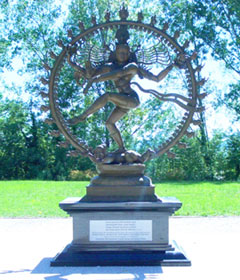 |
|
In appreciation of the feelings of modern physicists for Siva’s dance, the Government of India presented in June 2004 to the world’s leading laboratory in particle physics, a two metre tall statue of Nataraja, representing Siva engaged in His Cosmic Dance. This statute stands in the premises of CERN, an international laboratory located in Geneva, where many outstanding discoveries relating to the microcosm and its relationship to the macrocosm have been made.
As this great Yajna in Prashanti winds its way to conclusion, we devotees, wherever we are, must, taking help from the rituals and the chants, try to look far beyond so that we see ourselves not in the limited setting of daily life as father, mother, teacher, CEO or whatever, but with respect to where we came from and where we ought to go. As Swami reminds us, from Consciousness we all came and in Consciousness we must finally merge.
And Siva is one of the representations of that Supreme Consciousness. The worship of the Lingam, Abhishekams done to it, and the offerings made to the fire while chanting the name of Siva must all help us to focus on our true destiny and not the false destiny that the ephemeral world tempts us with. |
The Dancing Nataraja at CERN,Geneva |
|
|
I hope you agree with my conclusions. Thank you and Jai Sai Ram.
Dear Reader, how did you like this supplement to the cover story? Was it informative and inspiring? Please let us know at h2h@radiosai.org. Please mention your name and country when you write to us. Thank you for your time.
– Heart2Heart team

|
|




